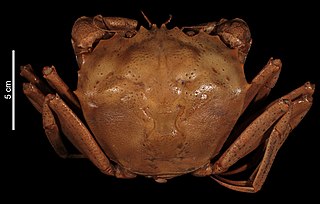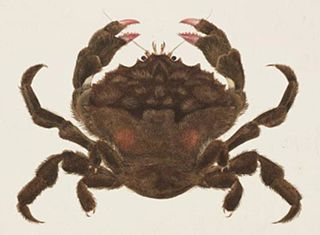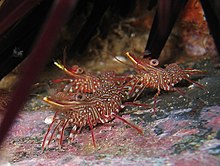
Squat lobsters are dorsoventrally flattened crustaceans with long tails held curled beneath the cephalothorax. They are found in the two superfamilies Galatheoidea and Chirostyloidea, which form part of the decapod infraorder Anomura, alongside groups including the hermit crabs and mole crabs. They are distributed worldwide in the oceans, and occur from near the surface to deep sea hydrothermal vents, with one species occupying caves above sea level. More than 900 species have been described, in around 60 genera. Some species form dense aggregations, either on the sea floor or in the water column, and a small number are commercially fished.

Portunoidea is a superfamily of crabs that includes the family Portunidae, the swimming crabs. Which other crab families are also placed here is a matter of some contention, and may be revised following molecular phylogenetic analyses.
Cherax parvus is a species of crayfish in the family Parastacidae. It is only known from its type locality – the Upper Tully River catchment in the Cardwell Range of north-eastern Queensland – and is listed as data deficient on the IUCN Red List. It was discovered in a rainforest catchment in a highland of northeastern Queensland during a Queensland Museum expedition to the upper Tully River area in November 1992. It is one of the smallest species in the genus. No species of Cherax has been considered endemic to wet upland or highland areas before it was discovered; most previous records were from elevations less than 400 meters. It also has several morphological features unique to the genus, and does not appear closely related to any extant species, suggesting a long period of geographic isolation.
Carcineretidae is a prehistoric family of heterotrematan crustaceans. They are only known from Cretaceous fossils. These crabs are tentatively placed in the superfamily Portunoidea and resemble the swimming crabs (Portunidae) in having some paddle-shaped pereiopods. But it is not certain that this placement is correct, as the Carcineretidae also show some similarities to the Matutidae of superfamily Leucosioidea and the Goneplacidae of superfamily Xanthoidea.

Parribacus antarcticus is a species of slipper lobster. Its common names include "sculptured mitten lobster" and "sculptured slipper lobster" in English, and ula-pehu and ula-pápapa in Hawaiian.

Oregonia bifurca, commonly known as the split-nose crab or the split-nose decorator crab, is a species of crabs belonging to the genus Oregonia. It is a rare deep-water species that inhabits the tops of seamounts and guyots in the northeastern Pacific Ocean; from the Aleutian Islands, the Bering Sea, the Hawaiian–Emperor seamount chain, to the waters off British Columbia. It is closely related to the more common shallow-water species Oregonia gracilis, the graceful decorator crab.

Rhynchocinetes durbanensis, commonly known as the camel shrimp and the hingebeak prawn, is a species of shrimp found in the Indo-Pacific. Up to 4 cm (1.6 in) in length, the shrimp has large black eyes, and features red and white lines on a translucent body. It has many white ocelli (spots) as well as a Y-shaped white mark on the upper front part of its carapace. It is strongly sexually dimorphic, and dominant males have larger first pair of chelipeds. The shrimp is found in hollows and crevices from 5 to 35 metres deep, where it forms groups consisting of dozens of individuals. One study determined that the ovigerous females carry from 267 to 1764 eggs, and the eggs take 9 days to hatch after spawning at a temperature of 29.2 °C (84.6 °F), or 18 days when the temperature is under 22.0 °C (71.6 °F). R. durbanensis has been frequently confused with R. uritai, and also closely resembles R. brucei. R. durbanensis was first described scientifically by Isabella Gordon in 1936.

Rhynchocinetes uritai also known as the camel shrimp, camelback shrimp, or dancing shrimp is a non-aggressive crustacean of the family Rhynchocinetidae. They are saltwater shrimp, and are common in saltwater aquariums.
Procaris hawaiana is a species of shrimp in the family Procarididae, from Maui, Hawaii. The species is very similar to Procaris ascensionis from Ascension Island. In P. ascensionis the integument is less firm, the rostrum is shorter, the cervical groove is more distinct, and the third abdominal somite reaches less far posteriorly over the fourth; also the scaphocerite has the final tooth still less distinct than in P. hawaiana, and the last segment of its antennal peduncle is less slender.
Palaemonella burnsi is a species of shrimp in the family Palaemonidae, from Maui, Hawaii. This species is closest to Palaemonella lata, which it resembles in the broad scaphocerite in which the lamella overreaches the final tooth, and in the unarmed merus of the second pereiopods. It differs from P. lata in the much longer fused part of the two branches of the upper antennular flagellum, in the relatively much longer fingers and shorter palm of the second legs, in the unarmed carpus of the second legs. It is named after John A. Burns, Governor of Hawaii, for declaring the Ahiki Kinau area a nature reserve.
Periclimenes pholeter, is a species of shrimp belonging to the family Palaemonidae. The species is closest to Periclimenes indicus, P. obscurus and P. toloensis, resembling these species in the presence of an epigastric tooth on the carapace, the shape of the abdomen, the spinulation of the carapace, and the unarmed fingers of the first chelipeds. P. pholeter most resembles P. indicus by the elongatecarpus and long fingers of the second pereiopods, differing in these features from P. toloensis, which has the fingers slightly less than half as long as the palm. In P. obscurus the fingers are shorter than the palm, but the carpus is about as long as the palm. From P. indicus, this species differs: by the greater size; by the much higher rostrum and the greater number of ventral rostral teeth; by the shorter eye; by the less slender antennular peduncle; by the more deeply cleft upper antennular flagellum; by the more robust scaphocerite; by the fingers of the first pereiopods ; by the more slender pereiopods, especially the fifth, which is much longer than the ischium.

Chaceon crosnieri is a species of crab.
Chaceon bicolor is a species of crab. Chaceon bicolor differs from all species of the genus in color pattern, with the anterior part of the body purplish rather than reddish. In addition to color pattern, C. bicolor also differs from C. granulatus in having compressed rather than depressed dactyli on the walking legs; also, the hepatic region of the carapace in C. granulatus is coarsely granular, whereas it is smooth in C. bicolor. Juvenile specimens differ from adults in many features: the teeth of the carapace are much larger and sharper, there is a sharp spine on the carpus of the cheliped and a distal spine on the merus of each walking leg, plus the legs are longer and slenderer. Adult females differ from males in having much sharper anterolateral teeth on the carapace, sharper suborbital spines, and much shorter legs, with less trace of a distal dorsal projection on the merus. The carapace of females is more strongly arched from front to back and the protogastric regions are noticeably more inflated. The species is named as such because of its colour patter, purple an tan.
Chaceon atopus is a species of crab. This species resembles C. gordonae, from the Cape Verde Islands and Sierra Leone, in many features: its large size, well-developed frontal and

Cinetorhynchus is a genus of shrimp in the family Rhynchocinetidae. It was originally described in 1995 by Lipke Holthuis as a subgenus of the genus Rhynchocinetes, but was elevated to the rank of genus by Okuno in 1997. Both genera share the characteristic jointed rostrum, but differ in the numbers and positions of various spines. Cinetorhynchus contains the following species:

Lauridromia is a genus of crabs in the family Dromiidae. It contains only two species. At one time a third species, Lauridromia indica, was included in the genus but that has now been transferred to the genus Dromidiopsis as Dromidiopsis indica.
Lauridromia intermedia is a species of crab in the family Dromiidae and is native to the western Indo-Pacific. It often carries a piece of sponge on its back by way of camouflage, and one individual was found carrying a sea anemone in a similar manner.
Alpheus tricolor is a crustacean belonging to the family of snapping shrimp. It was first isolated in Indonesia and Sri Lanka. It counts with a setose carapace, an acute rostrum, shallow adrostral furrows and a basicerite with a strong ventrolateral tooth. The lamella of its scaphocerite is not reduced, with an anterior margin that is concave. Its third maxilliped counts with an epipodial plate bearing thick setae, while its first chelipeds are found with their merus bearing a strong disto-mesial tooth; its third pereiopod has an armed ischium, with a simple and conical dactylus. Its telson is broad, distally tapering, with 2 pairs of dorsal spines. The species is named after its characteristic colour pattern, including white, red and orange.

Alpheus fasqueli is a crustacean belonging to the family of snapping shrimp. It was first isolated in Sri Lanka. It counts with a setose carapace, an acute and carinate rostrum, and unarmed orbital hoods. Its basicerite has a strong ventrolateral tooth. The lamella of its scaphocerite is not reduced. Its third maxilliped counts with an epipodial plate bearing thick setae, while its first chelipeds are found with their merus bearing a strong disto-mesial tooth; its third pereiopod has an armed ischium, with a simple and conical dactylus. Its telson is broad, distally tapering, with 2 pairs of dorsal spines. The species is named after Frédéric Fasquel, a photographer who contributed rare shrimp specimens for the Muséum national d'histoire naturelle.

Cinetorhynchus rigens is a species of shrimp in the family Rhynchocinetidae. Common names include mechanical shrimp, Atlantic dancing shrimp, red night shrimp and red coral shrimp. It occurs in shallow water in the tropical Atlantic Ocean.











